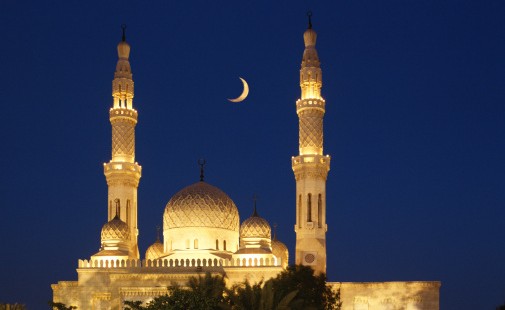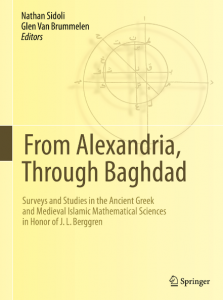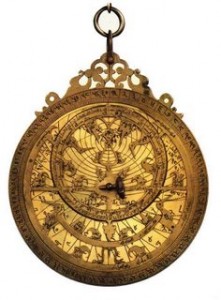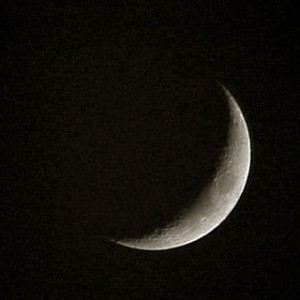
Source: http://gulfbusiness.com/2014/07/first-day-eid-al-fitr-expected-fall-july-28/
The following two linked articles offer glimpses into the relationship between Islamic scholarship and the determination of the precise times of both the beginning of Ramadan and the appearance of the Shawwal crescent moon marking the first day of Eid Al Fitr at the end of the month of Ramadan.
What I find fascinating given my interest in ancient Jewish astronomy are the similar debates among religious scholars in both Islam and Judaism regarding the use of observation vs. astronomical calculation to determine the times of the holy days.
In Judaism, a functioning fixed calendar eventually came to exist by the early medieval period after centuries of debate, calendrical authority struggles, and the evolution of calendrical rules. Prior to these developments in Late Antiquity, the Jewish calendar was based on observations of the first lunar crescent, called the molad. Prior to Late Antiquity, during the Second Temple period and the Persian period, other time-reckoning systems were in use, some solar and some lunar.
In Islam, my understanding (perhaps colleagues in Islamic studies can clarify this further) is that various opinions and practices exist, with some countries relying on the traditional hilal sightings of the new crescent moon (for example, to establish the beginning of Ramadan) with the naked eye, some Muslims relying upon the visual sighting of the lunar crescent in either Saudi Arabia or their own country, and others using astronomical calculations.
(There is much that unites Judaism and Islam.)
A blessed Eid to all who celebrate it!

Sidoli, Nathan and Van Brummelen, Glen, Eds. 2014. From Alexandria, Through Baghdad: Surveys and Studies in the Ancient Greek and Medieval Islamic Mathematical Sciences in Honor of J.L. Berggren. [Hardcover]
Of interest to scholars and students of the history of mathematics and astronomy in ancient Greece and Medieval Islam is this volume, honouring the career of history of mathematics professor J.L. Berggren. The volume includes contributions spanning approximately seventy years of research, from the mid twentieth century onward.
Notable astronomical chapters include:
James Evans and Christian Carlos Cartman, “Mechanical Astronomy: A Route to the Ancient Discovery of Epicycles and Eccentrics.”
Alexander Jones, “Some Greek Sundial Meridians.”
and
David A. King, “An Ottoman Astrolabe Full of Surprises.”
For more information, please see the Springer web site.
This online article on research conducted by Dr. Benno van Dalen of the Institute for the History of Science at LMU Munich is a few years old, but too fascinating to gloss over.
Tags: andrea d lobel, andrea lobel, Astronomy, Benno van Dalen, cultural astronomy, ethnoastronomy, History of Astronomy, Islam, Medieval China
Just a quick peek behind the workings of this blog. I’m currently spending much of my time reading materials in preparation for my comprehensive exams. (a.k.a. qualifying exams) For now, as has been the case for a few months, until these exams are completed, I only have a limited amount of time to devote to Chaldea (i.e., I’ll post whenever I can). I thought I’d bring a notable source I’m working with to the attention of others in similar fields.
For those interested in cultural perceptions of the heavens in ancient Egypt, Mesopotamia, ancient Israel, Persia, Greco-Roman cultures, as well as early Judaism, Christianity, and Islam, I highly recommend The Early History of Heaven, by J. Edward Wright. (2000, Oxford University Press)
I first took it out of the library in 2003, but soon found it indispensable, so I bought a copy. It’s a very thorough overview of the important writings and beliefs about heaven and/or the heavens (including heavenly cosmography) in these cultures, and it incorporates archaeological findings as well as textual sources. It is difficult to distinguish between astronomy proper and astral beliefs in many ancient civilizations; this book provides the reader with a solid awareness of the background views of the cosmos in these cultures, thereby setting the stage for later evolutions in cultural astronomy.
Have a good weekend, all!

Fourteenth century Islamic astrolabe, Whipple Museum
This video item from ABC (Australia), complete with transcript, features Dr. Sheikh Muszaphar Shukor, the first Muslim astronaut to travel into space during Ramadan. This led to the need for Muslim scholars to carefully determine the rules that would apply to prayer in outer space, not to mention the ubiquitous question “Which way is Mecca?”
I was especially interested in the reference to Islam’s “golden age” (circa 8th-16th centuries CE) during which Muslim scientists made various vital contributions to the world in the areas of mathematics and astronomy. This, of course, includes the invention of such devices as the astrolabe, pictured above.
For more information on Dr. Shukor, Wired published an earlier story about his career as an astronaut.
This article, in the Vancouver Sun, is the first of a series on the topic of science and religion. Of particular interest is the reference to “the striking similarity between 16th-century Polish astronomer Nicolas Copernicus’s arguments for the Earth’s rotation and those of 13th-century Muslim polymath Nasir al-Din al-Tusi”, noted by science historian and Islamicist Dr. F. Jamil Ragep of McGill University.

This recent article in the Ottawa Citizen describes some of the controversy surrounding the astronomical moment at which the month of Ramadan is over. This, of course, is signaled by the appearance of the new crescent moon. The question, however, is that of exactly where this first lunar crescent must be sighted — from one’s own city or from Mecca. Furthermore, does the latter option invalidate the primacy of aeons of naked-eye viewing of the new lunar crescent in Islam?
This is ultimately about the question of religious authority, and as such, it summons to mind other similar challenges posed by the matter of first lunar visibility. In ancient Judaism, for example, the new month was once proclaimed first based upon a system in which an initial viewer of the new crescent would light a signal-fire on a mountain or hill-top to notify the next viewer, who would then light another signal-fire, and so on. This practice was disrupted by the deliberate lighting of signal-fires at the wrong time by the Samaritans of the first century. This practice was soon replaced by a system involving witnesses of the new crescent, who would then be carefully interrogated by Jewish authorities. Upon establishing the credibility of given witnesses, the new month would be proclaimed. This matter was, of course, crucial to the timing of important religious festivals such as Passover and the New Year. Later, the fixed, calculated Jewish calendar would come to replace visual observation of the moon for religious purposes — a critical transition within Judaism, to be sure, and one which had its origins in the political nature of calendrics and its reliance upon astronomical viewing.
It is, perhaps, notable, that the small community of remaining Karaites continues to rely on direct visual observation of the lunar crescent, having never adopted the beliefs, interpretations and rituals of Rabbinic Judaism.




